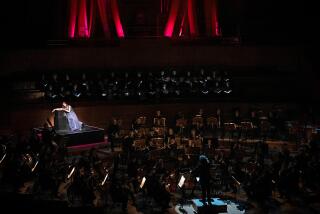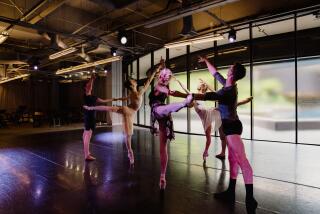High-Speed Wonders
- Share via
You can think of them as the ultimate inexhaustible speed demons of modernism, but velocity and stamina are just the most obvious hallmarks of the dancers belonging to the 29-year-old, Philadelphia-based institution known as Philadanco. Precision is another, for even if they look permanently on overdrive, their onrush of dancing delivers the sharpest freeze-frames imaginable: poses and movement accents of perfect clarity.
This aptitude served them well on Saturday in a four-part program at El Camino College in Torrance that explored the spectrum from just-plain-fast to wildly supersonic. The only remotely unhurried choreography came when Tracy Vogt methodically executed ballet extensions off a high stepladder during Talley Beatty’s slick and shallow “Pretty Is Skin Deep, Ugly to the Bone.” Dating back to 1976, this large-scale pop showpiece plundered the ballet vocabulary for bravura, added a few streetwise gestures for seasoning and pasted titles on the various sections implying some overriding social significance or agenda--titles such as “Ghettoscape” and “Soul Saga.”
For those kind of values, as well as rhythmic drive, Beatty relied on his record collection: jazz and blues by Earth, Wind and Fire, Natalie Cole and Quincy Jones. Fortunately, such wonders as Vogt’s balances and the air turns of William N. Grinton provided potent distractions from the choreographic emptiness. Moreover, company resident choreographer Milton Myers proved a master of Beatty-style ensemble effects in the excerpt from his purposeful and sophisticated “Echoes: A Celebration of Alvin Ailey.”
*
Set to John Adams’ “Fearful Symmetries,” this tribute used movement quotes from the Ailey rep as a springboard to new invention--quotes sometimes more or less exact (a sassy lineup from “Night Creature,” for example), but often recontextualized (the reaching moves from the “Revelations” prologue set against the huge orange sun of its finale). Throughout, Myers treated Ailey’s work as a true creative legacy--something to be built upon--and the dancers responded devotedly, led by Vogt, Hope Boykin, Curtis Glover and Brandon Ellis.
Isolated women served as a group focus or catalyst in both Elisa Monte’s “Dreamtime” and Donald Byrd’s “Bamm.” Using music by David Van Tiegham, the Monte octet developed a stiff-armed vocabulary for the corps and then introduced finger-shimmers and other new motifs in solos by Kim Y. Bears--innovations eventually adopted by everyone. Intense and forceful, Bears seemed to represent a kind of prophet or seer in this complex and involving work based on Australian aboriginal mythology but with no conventional narrative to limit its implications.
To an original percussion score by Mio Morales, the Byrd septet found Candace Whitaker initially encircled by the corps, then temporarily joining its various factions when confrontational oppositions occurred. Eventually, in the piece’s most compelling passages, she became involved in a passionate but enigmatic relationship with Glover. As she trembled in his arms and tried to break free, you wondered whether he was trying to trap her or calm her--questions that lingered as he shadowed her in convulsive, nonstop turning-leaps and floor-rolling that Byrd set against a series of formal group marches.
*
Like nearly all of Byrd’s best work, “Bamm” infused showcase-level dancing with a sense of volatile sexual politics, emerging far superior in its conceptual economy and rigor to his disjointed, overblown full-evening projects “The Harlem Nutcracker” and “Jazz Train.” And, once again, Philadanco excelled at quick-change transitions between moves borrowed from the ballet barre and those belonging to the boogaloo.
More to Read
The biggest entertainment stories
Get our big stories about Hollywood, film, television, music, arts, culture and more right in your inbox as soon as they publish.
You may occasionally receive promotional content from the Los Angeles Times.










